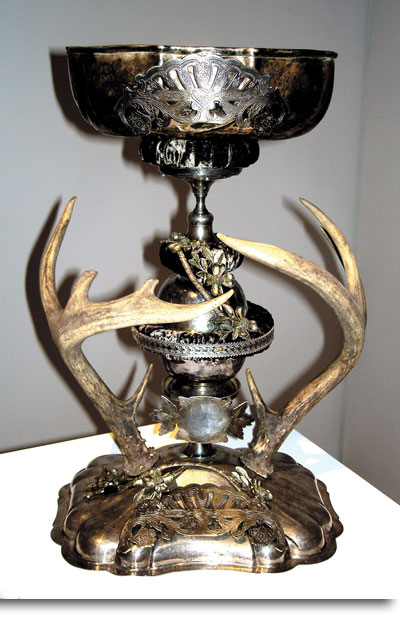Aug 2008

PORTLAND
Sonia Kasparian at Butters
Gallery
In Alter, Sonia Kasparian departed from her customary
overpainting of photographs on screens while continuing to use the screen as an
expressive medium. Grounded in the figure, her previous work had an elegiac
quality, multi-layered and harkening to nostalgia, whereas the current
exhibition foregoes the figure for a semi-abstraction that, while flirting with
decorative motifs, nevertheless remains grounded in human concerns. The
centerpiece of Kasparian’s July show was a set of fastidious, hand-cut wall
hangings fashioned out of porch-screen material, fishing paraphernalia, and
sundry other materials culled from the artist’s recent trip to Southeast Asia.
With their scrolls, turns, curls, and frills, the works projected a baroque
effulgence, tempered by a more corporeal sensibility owing to their bony,
vertebral outcroppings. Some of the hangings are quite large (Double Mothra
extends 8½ feet vertically and 3½ feet across) and coalesce vertically around
metal beads, which terminate in weights used for fishing tackle. Other works
such as the pelvis-like Mothra and black pearl-laden Rodan further play off an
unlikely mélange of 17th Century opulence, the human body, and vintage Japanese
monster movies.
An element of memento mori enters into Kasparian’s
sculptural pieces, which amalgamate second-hand ephemera with animal bones she
happens upon and unsqueamishly gathers during road trips. In Shiva, the artist
covers a deer skull with an armor-like metal mask, provoking the viewer to muse
exactly how a sheath of armor might protect a creature that is already dead.
Going deeper, it also asks how we ourselves, Botox-pumped and fresh from
pilates, would presume to immortalize ourselves, though we be, as Yeats wrote,
“sick with desire and fastened to a dying animal.” For John caps the ribs of
some unfortunate road kill with silver tips and spreads the bones out like
butterfly wings, an outspread fan of silver filigreed on top. Kasparian entwines
antlers around a tarnished silver goblet in Loving Cup, which comes across as a
sad Holy Grail hocked at a taxidermist’s garage sale. The mix-and-match motif
continues in Mandala, Vessel of the Vassal, and Of the Father I and II, with
their found velvets, candelabra, platters, and hookahs.
The fevered
invention of these permutations and the artist’s tongue-in-cheek humor keep the
work’s gothic romanticism one step away from freefall into Anne Rice territory.
In Kasparian’s meticulous repurposing of found objects both organic and
man-made, she invites the viewer into a sly purgatory halfway between gloom and
levity.
